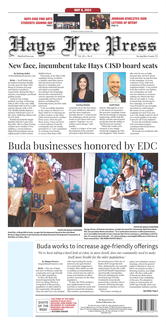By Kim Hilsenbeck
Whether because of recent officer-involved shootings or because of TV shows like COPS, people want better video – and audio – when it comes to police.
Now, Buda police might be the first in the nation to take real action when it comes to body-worn automatically activated cameras.
Buda police officers wear body cameras because Chief Bo Kidd is an advocate for technology.
“You see a totally different perspective [with the cameras],” he said.
Working with Taser’s Axon, Kidd was sold on body-worn cameras that are automatically activated. Whether it’s when patrol car lights are activated or when an officer steps out of the vehicle, body-worn camera works so much better than in-vehicle cameras. The sound, the visual and the extent and distance away from the scene is better with body-worn cameras.
But the automatically activated cameras are even better, according to Kidd.
“We had an incident with [Officer] Barry Lee,” he said. “We got a call for a theft in progress. [Lee] pulls up, the guy takes off … so the chase is on. The in-car camera automatically turns on when an officer activates his or her overhead (i.e., flashing) lights.”
When Lee got back to the station, Kidd wanted to see the video.
“He forgot to turn on the camera,” Kidd said. “But can you blame the officer in the heat of the moment?”
That’s because that camera had to be turned on manually.
This situation would be different with automatic cameras.
“Common sense tells you that if they roll up on something in progress, they shouldn’t be thinking about turning on a camera. They should be thinking about safety,” he said.
Kidd said Buda will be the first department in the nation to obtain body-worn cameras that will activate automatically during certain situations.
Tiny sensors near guns or Taser weapons will signal the camera to activate. In the future, the cameras will begin recording based on an officer’s biometrics such as a faster heartbeat.
That technology is in development, Kidd said, but the cameras they have now turn on when an officer turns on a police vehicle’s flashing lights.
“As soon as you hit the lights, it kicks on for you,” Buda Police Officer Luke Lysek said.
“It’s a sensor that has a certain range,” Kidd said. “It will activate all officers’ cameras within that range during that 30 seconds.”
Once activated, there is a 30-second hold while the camera rewinds and then captures the last half of a minute. In a way, Kidd said, it’s as if the camera is always on, always filming, but it doesn’t always record.
That hold is important, because if an officer sees a violation, his camera is on and will then record that incident.
The hold can help with non-violations, like police vehicle accidents, such as collisions with deer.
Kidd said this happened recently, and the 30 seconds of video shows two deer running in front of the car.
Another video showed a response with a man passed out in the front seat of a pickup truck, keys in ignition and empty beer cans all around.
With a dash camera, the only view would be from the front of the police vehicle. With body-worn cameras, they see whatever the officer sees no matter where they move.
“You see a totally different perspective [with the body cameras],” he said.
Kidd said he prefers the cameras worn over the ear, close to the eye, over those worn on the officer’s chest.
“If an officer turns to see something but only uses his or her head, the camera on the chest won’t see what they’re looking at,” Kidd said. “But a camera next to their eye will see what they see.”
Kidd said these cameras automatically adjust to night vision video as needed.
“I’m almost inclined to get rid of the in car cameras,” Kidd said.
Those units cost about $5,500 per unit; Kidd said if he decides to stop using in-vehicle cameras, the department won’t repair or replace them.
“For now, we’ll continue with the redundancy. If these capture everything we need, I’m inclined to save the money and spend it elsewhere,” he said.
Kidd believes the cameras offer protection for the public and law enforcement.
“This is accountability and transparency for everybody,” he said.








